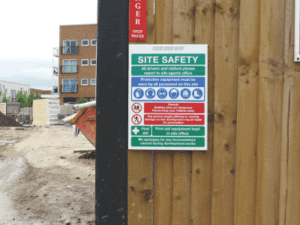Every day, millions of people head to work across the UK—some stepping into jobs that carry a much higher risk than others. From construction sites to care homes, workplaces are filled with hazards that, if not managed properly, can lead to serious injury or even death. This is the top 10 most dangerous jobs in the UK!
At Stocksigns, we believe that clear, effective signage is one of the most powerful tools available for keeping workers safe. Whether it’s warning of high voltage, directing traffic on a site, or reminding staff to wear PPE, safety signs play a vital role in accident prevention and life preservation.
Based on data from the Health and Safety Executive (HSE), here’s a breakdown of the UK’s most dangerous jobs—and how the right signage solutions can reduce risk and save lives.
1. Construction – The Most Dangerous Industry
39 fatalities in 2023 | 4x higher than other industries
With falls from height, heavy machinery, and unstable surfaces, construction is consistently the most hazardous industry in the UK.
Signage Saves Lives:
-
Fall Prevention: “Danger: Fragile Roof” or “Use Safety Harness” signs near risky areas help keep workers alert.
-
Machinery Awareness: Clear “Moving Vehicles” or “Keep Clear of Machinery” signs reduce the risk of being struck or crushed.
-
PPE Reminders: Helmets, gloves, high-vis clothing, and eye protection signs ensure workers don’t forget vital gear.

2. Agriculture & Farming
High rates of machinery injuries, chemical exposure, and suffocation
Farmers work in unpredictable environments, often with large animals, heavy equipment, and hazardous chemicals.
Signage Solutions:
-
Chemical Safety: COSHH-compliant signs alert staff to toxic, flammable, or corrosive materials.
-
Silo & Storage Warnings: “Confined Space – Authorised Personnel Only” signs reduce the risk of suffocation.
-
Animal Warning Signs: Indicate areas where livestock are present and advise caution.

3. Manufacturing
Risk of burns, crush injuries, and machinery entanglements
Industrial environments often involve high temperatures, sharp tools, and moving parts.
Signage Matters:
-
Machine Safety: Signs like “Do Not Operate Without Guarding in Place” help prevent accidents.
-
Hearing Protection: Noise hazard signs encourage workers to protect their ears in loud environments.
-
Fire Hazards: Clearly marked fire exits and “No Smoking – Flammable Material” signs are critical.

4. Care & Nursing
High exposure to infection, stress, and manual handling injuries
Often overlooked as “dangerous,” care workers face risks every day, particularly from physical strain and biological hazards.
Signage in Care Settings:
-
Hygiene Reminders: “Wash Hands Before and After Contact” signs reduce infection transmission.
-
Patient Handling: “Use Lifting Aids – Manual Lifting Prohibited” improves compliance with safe handling practices.
-
Emergency Info: Clear evacuation maps and fire safety signage save crucial seconds in an emergency.

5. Waste Management
Exposure to heavy lifting, chemicals, and dangerous machinery
Handling refuse and recyclables is far more dangerous than many realise.
Signage for Safer Waste Facilities:
-
Vehicle Movement: Signs like “HGV Access – Proceed with Caution” help reduce vehicle-related incidents.
-
PPE Enforcement: Ensure gloves, boots, and eye protection are worn.
-
Hazardous Waste Warnings: Clear labelling of hazardous bins protects workers from chemical exposure.

6. Office & Admin Roles
Stress, poor posture, and trip hazards cause more damage than expected
While offices may seem low-risk, prolonged sedentary work, clutter, and stress pose real health threats.
Safety Signage for Offices:
-
Ergonomic Advice Posters: Promote safe workstation setup.
-
Trip Hazard Signs: Mark uneven floors or trailing cables.
-
Mental Health Awareness: Signage reminding staff about available support services can foster a healthier environment.

7. Scaffolding & Roofing
Falls account for 29% of all workplace deaths
Working at height is inherently dangerous—often with little margin for error.
Height Safety Signage:
-
Edge Warning Signs: “Caution: Unprotected Roof Edge” signs prevent missteps.
-
Access Notices: “Scaffold Not Complete – Do Not Use” signs alert workers to unsafe platforms.
-
Fragile Surface Warnings: Protect roofers with prominent signage on skylights and brittle materials.

8. Paramedics & Firefighters
Exposure to trauma, disease, and dangerous environments
Emergency responders rely on clear communication to work safely in unpredictable conditions.
Signage in Emergency Services Facilities:
-
Biohazard Warnings: Highlight areas with risk of infection or contamination.
-
Decontamination Instructions: Simple, effective signage can reduce risk after exposure.
-
Stress Support Posters: Reinforce that help is available after difficult calls.

9. Mechanics
Traps, falls, and flammable hazards are widespread in vehicle workshops
From tools left on the floor to suspended cars, mechanics face danger at every turn.
Workshop Signage Essentials:
-
Lift Use Warnings: “Do Not Work Under Unsecured Lift” signs can be life-saving.
-
Fuel Handling Signs: Prevent fire risks with “No Smoking – Fuel Handling Area” notices.
-
Manual Handling Warnings: Encourage proper lifting techniques.

10. Lorry Drivers
Fatigue, collisions, and health complications pose hidden threats
Truck driving comes with long hours, stress, and significant health risks.
From tools left on the floor to suspended cars, mechanics face danger at every turn.
Signage for Logistics Hubs:
-
Speed Limits & Vehicle Routes: Minimise accidents with directional signage in depots.
-
Driver Health Posters: Remind staff of the risks of fatigue, dehydration, and diet.
-
Rest Break Reminders: Encourage regular breaks to reduce the risk of accidents.

Make Safety Visible
No matter the industry, signage is a critical safety measure. At Stocksigns, we provide a complete range of health and safety signage, custom solutions, and guidance to help businesses meet HSE compliance, reduce risk, and protect lives.
Is your signage up to standard? If you’re unsure, our experts can help assess your current signage setup and recommend improvements tailored to your industry.
